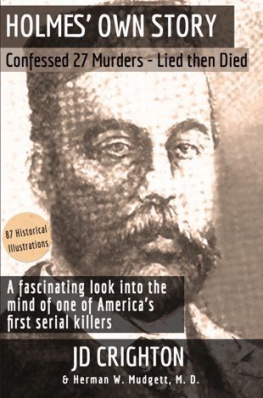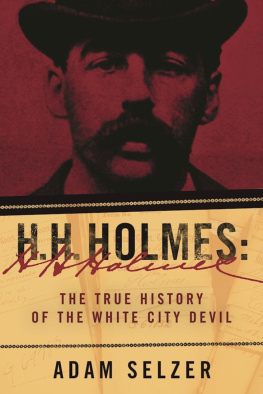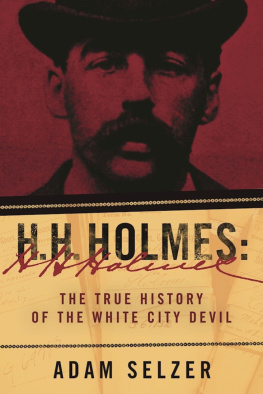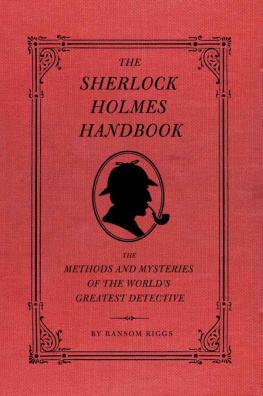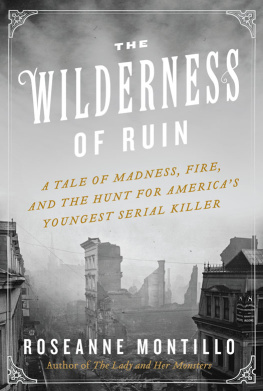DETECTIVE IN THE WHITE CITY
The Real Story of Frank Geyer
JD Crighton
Copyright 2017 by JD Crighton
All rights reserved
Cover design by Kristin N. Spencer

RW Publishing House
Murrieta, California
www.rwpublishinghouse.com
Ninety-five (95) historical photos and illustrations
PUBLISHERS CATALOGING-IN-PUBLICATION DATA:
Names: Crighton, JD, author.
Title: Detective in the White City : the real story of Frank Geyer / JD Crighton.
Description: Murrieta, CA : RW Publishing House, 2017. | Includes bibliographical references and index.
Identifiers: LCCN 2017961027 | ISBN 978-1-946100-02-3 (pbk.) | ISBN 978-1-946100-05-4 (large print pbk.) | ISBN 978-1-946100-04-7 (hardcover) | ISBN 978-1-946100-03-0 (ebook)
Subjects: LCSH: Geyer, Frank P. | Mudgett, Herman W., 1861-1896. | Detectives--United States--Biography. | Serial murderers--Illinois--Chicago. | Chicago (Ill.)--History--1875- | BISAC: TRUE CRIME / Murder / Serial Killers. | HISTORY / United States / State & Local / Midwest (IA, IL, IN, KS, MI, MN, MO, ND, NE, OH, SD, WI) | HISTORY / United States / 19th Century.
Classification: LCC HV6248.M8 C75 2017 (print) | LCC HV6248.M8 (ebook) | DDC 364.152/32--dc23.
In memory of
Mrs. Mary Elizabeth Geyer and
Edna Camilla (Geyer) Strohm
The wife and daughter that lived
CONTENTS
LIST OF ILLUSTRATIONS
(Illustration sources are listed with each individual image)
The page divider image used throughout the book is a common bank robbers tool called a sectional jimmy (shown below)

Sectional Jimmy Source:
Sprogle, Howard O. The Philadelphia Police, Past and Present. Philadelphia, PA: publisher unknown, 1887, p. 283.
PROLOGUE: PROFOUND UNTRUTH
I want you to listen to these statements. They are marvelous productions in the line of fiction; they are wonderful statements, with scarcely an element of truth in them.
-District Attorney George S. Graham,
Commonwealth v. Mudgett, alias Holmes
SOMEWHERE IN THE MIDST of a great story was a profound untruth so dark, that if true, would have wiped the direct line of Detective Frank Geyers future generations of family off the face of the earth. A fabrication told and retold to readers young and old.
No, Detective Geyer did not experience enormous personal tragedy in March 1895, before the world knew he investigated H. H. Holmes, the killer known in the twenty-first century as the Devil in the White City. No, a fire did not consume Geyers home, killing his beloved wife, Martha, and only child... Esther, as an author wrote, and because no loss happened, Geyer was not infused with even greater zeal for the search. These untruths did not take place. Even so, the story of the deaths perpetuated in the United States, internationally, and online, to the disappointment of Geyers descendants.
How could nonfiction authors get it so wrong? Was the inaccuracy written to stir up emotions and suck readers deeper into a great story, or an honest, albeit, catastrophic mistake? For, the story of the deaths were not just a few erroneous facts, it was the death of two family members.

Her name was Mary not Martha, and the Irish beauty never died in a house fire. Frank met his beautiful bride while she waited tables at a tavern across from where his longtime police district would soon move to at the corner of Fourth and York. Police frequented taverns to nab criminals while on duty and to unwind after a long, stressful day at work. At the time, Philadelphia had an abundance of taverns and saloons, many doubling as homes with a simple sign placed above the door that read [last name of resident] Tavern. People could walk next door, or a few blocks to a tavern managed by a neighbor. With 5,444 of them in Philadelphia in 1877, there was practically one on every corner.
Geyers family wasn't thrilled with the relationship, not only because Mary was a barmaid, but because, like many Irish at the time, her parents had immigrated to the United States in poverty. Most people in Ireland had depended on potatoes for food and when crops failed three years in a row, over 750,000 Irish starved to death. Two million survivors immigrated to the United States. Geyers German ancestors also immigrated, but most had enough money to settle comfortably. Americans were hostile towards Irish at the time, primarily for religious differences and because they worked for less than people in low-paying jobs. To drive home their point, signs appeared in windows and on doors that read, No Irish Need Apply
Geyer's ancestors were prominent, well-educated people traced to the Founding Fathers of America. His ancestors could also be traced to a General of the Revolutionary War, as a reporter wrote in 1895. Geyer, opposed to making more than a few statements during interviews, stood next to Mr. Gary from Fidelity Mutual Life Association, while he told the reporter Geyer was a descendant of a general.
Mr. Gary pays him the high compliment to say that he would be fully the equal, if not the superior, of his ancestor in case he were called upon for the same service. The reporter wrote that Mr. Gary did most of the talking, while Geyer corrected him as needed to get the facts straight. Most of the story as given... was obtained from Mr. Gary, although occasionally Mr. Geyer would make a remark in the way of correction as to detail, the Indianapolis Journal reported.
In contrast to Geyers family, Mary was penniless, except for the small amount she earned at the tavern.
Although Mary had a fine head for business, she was illiterate, and like many women in the mid-nineteenth century, she could neither read nor write.
But all those things were meaningless to Geyerhollow and insignificant. For how prominent or wealthy you are, or even how well you read or write, doesnt define you as a person.
Geyer knew if he persisted, his family would come to their senses, and they did. Charmed and fascinated with the Hartford, Connecticut Irish beauty, thirty-one-year-old Geyer proposed, and Reverend W. S. Pugh married the couple on a chilly, partly cloudy Monday, March 9, 1885.
Frank and his real wife, Mary, lived a happy and fulfilling life together, rich with wonderful family memories, traditions, and celebrations. On a wintery-white day in December 1886, the devoted couple had a beautiful part-Irish, part-German baby girl named Edna, not Esther, and she never died in a house fire either. No such thing ever happened. Mr. and Mrs. Geyer celebrated all of Edna Camillas milestonesfirst words, first steps, teenage years, graduation, marriage, and childrenFrank and Marys grandchildren.
Indeed, Frank and Mary celebrated thirty-three wedding anniversaries and enjoyed all the usual family traditions. They were a family long endeared to law enforcement, except for a few, brief frustrations over the years. Good at his job, Geyer ranked among the best of the best. He worked hard and earned titles like World Famous Detective, Murder Detective, Murder Geyer, and the silly, Electric Detective.
Mary stood by him during city and department turmoil that happened off and on, especially after elections. She sympathized with well-publicized disciplinesa couple aimed at Geyerand large-scale terminations and arrests of fellow officers, that, for good reason, bypassed her husband. And Mary mourned right alongside Geyer at heart-wrenching officer suicides and deaths, some while on duty. The law enforcement family life was rough but also rewarding.
Next page
